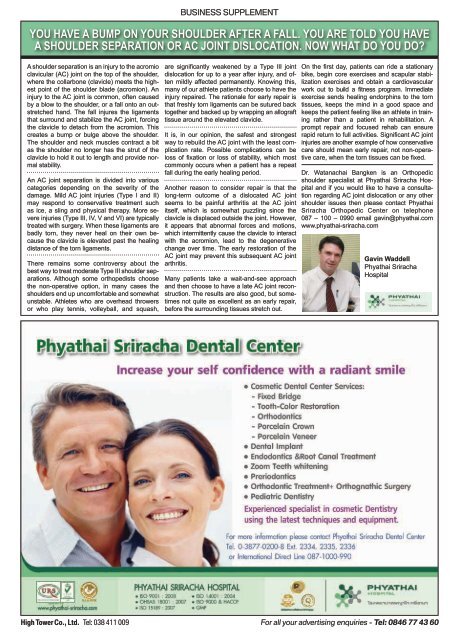WEB PBS JULY 17
Create successful ePaper yourself
Turn your PDF publications into a flip-book with our unique Google optimized e-Paper software.
BUSINESS SUPPLEMENT<br />
YOU HAVE A BUMP ON YOUR SHOULDER AFTER A FALL. YOU ARE TOLD YOU HAVE<br />
A SHOULDER SEPARATION OR AC JOINT DISLOCATION. NOW WHAT DO YOU DO?<br />
A shoulder separation is an injury to the acromio<br />
clavicular (AC) joint on the top of the shoulder,<br />
where the collarbone (clavicle) meets the highest<br />
point of the shoulder blade (acromion). An<br />
injury to the AC joint is common, often caused<br />
by a blow to the shoulder, or a fall onto an outstretched<br />
hand. The fall injures the ligaments<br />
that surround and stabilize the AC joint, forcing<br />
the clavicle to detach from the acromion. This<br />
creates a bump or bulge above the shoulder.<br />
The shoulder and neck muscles contract a bit<br />
as the shoulder no longer has the strut of the<br />
clavicle to hold it out to length and provide normal<br />
stability.<br />
An AC joint separation is divided into various<br />
categories depending on the severity of the<br />
damage. Mild AC joint injuries (Type I and II)<br />
may respond to conservative treatment such<br />
as ice, a sling and physical therapy. More severe<br />
injuries (Type III, IV, V and VI) are typically<br />
treated with surgery. When these ligaments are<br />
badly torn, they never heal on their own because<br />
the clavicle is elevated past the healing<br />
distance of the torn ligaments.<br />
There remains some controversy about the<br />
best way to treat moderate Type III shoulder separations.<br />
Although some orthopedists choose<br />
the non-operative option, in many cases the<br />
shoulders end up uncomfortable and somewhat<br />
unstable. Athletes who are overhead throwers<br />
or who play tennis, volleyball, and squash,<br />
are significantly weakened by a Type III joint<br />
dislocation for up to a year after injury, and often<br />
mildly affected permanently. Knowing this,<br />
many of our athlete patients choose to have the<br />
injury repaired. The rationale for early repair is<br />
that freshly torn ligaments can be sutured back<br />
together and backed up by wrapping an allograft<br />
tissue around the elevated clavicle.<br />
It is, in our opinion, the safest and strongest<br />
way to rebuild the AC joint with the least complication<br />
rate. Possible complications can be<br />
loss of fixation or loss of stability, which most<br />
commonly occurs when a patient has a repeat<br />
fall during the early healing period.<br />
Another reason to consider repair is that the<br />
long-term outcome of a dislocated AC joint<br />
seems to be painful arthritis at the AC joint<br />
itself, which is somewhat puzzling since the<br />
clavicle is displaced outside the joint. However,<br />
it appears that abnormal forces and motions,<br />
which intermittently cause the clavicle to interact<br />
with the acromion, lead to the degenerative<br />
change over time. The early restoration of the<br />
AC joint may prevent this subsequent AC joint<br />
arthritis.<br />
Many patients take a wait-and-see approach<br />
and then choose to have a late AC joint reconstruction.<br />
The results are also good, but sometimes<br />
not quite as excellent as an early repair,<br />
before the surrounding tissues stretch out.<br />
On the first day, patients can ride a stationary<br />
bike, begin core exercises and scapular stabilization<br />
exercises and obtain a cardiovascular<br />
work out to build a fitness program. Immediate<br />
exercise sends healing endorphins to the torn<br />
tissues, keeps the mind in a good space and<br />
keeps the patient feeling like an athlete in training<br />
rather than a patient in rehabilitation. A<br />
prompt repair and focused rehab can ensure<br />
rapid return to full activities. Significant AC joint<br />
injuries are another example of how conservative<br />
care should mean early repair, not non-operative<br />
care, when the torn tissues can be fixed.<br />
Dr. Watanachai Bangken is an Orthopedic<br />
shoulder specialist at Phyathai Sriracha Hospital<br />
and if you would like to have a consultation<br />
regarding AC joint dislocation or any other<br />
shoulder issues then please contact Phyathai<br />
Sriracha Orthopedic Center on telephone<br />
087 – 100 – 0990 email gavin@phyathai.com<br />
www.phyathai-sriracha.com<br />
Gavin Waddell<br />
Phyathai Sriracha<br />
Hospital<br />
High Tower Co., Ltd. Tel: 038 411 009<br />
For all your advertising enquiries - Tel: 0846 77 43 60

















